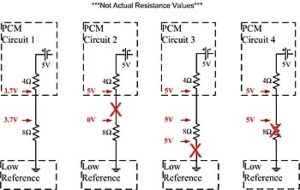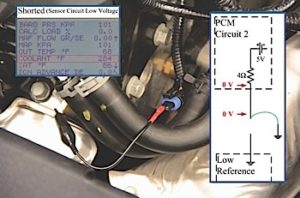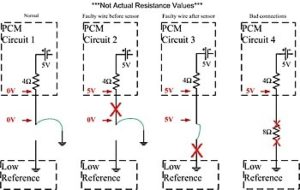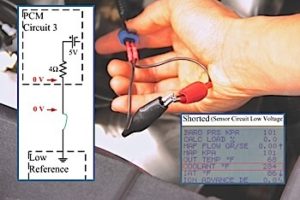
Taking the Trouble of Using Diagnostic Trouble Codes
October 28, 2013
In the last issue, we looked at the wiring schematics of sensor circuits (The Semantics of Schematics). In this article, we’ll take a deeper look into the roll of DTCs with electrical sensor diagnosis.
We all know that understanding basic electrical principles and sensor circuits will allow any technician to efficiently diagnose any complex computer-controlled system. However, due to the current compact design of connectors and wires, it’s now very difficult to acquire any voltage measurements at a connector through probe-type tools such as a t-pin.
Fortunately, using a scan tool, DVOM and a jumper wire kit can alleviate this problem.
It’s always wise to start the diagnostic procedure by verifying the customer complaint and checking for DTCs. However, technicians must first understand how DTCs are set and interpret what voltages the module should and is currently seeing. Furthermore, the technician must analyze the circuit to verify if it utilizes a PU or PD resistor. The resistors will always be on the signal side of the module, not the 5-volt reference or low-reference side of the sensor. Variable resistive-type sensors with a low-reference wire will utilize a PU resistor on the sensing side. On the other hand, sensors with a 5-volt reference wire, will utilize a PD resistor on the sensing side.
Diagnosing Switch Inputs
All DTCs are set by certain malfunction conditions. Input switches, such as a brake pedal switch, normally experience the lowest and highest voltage parameters (0 or source voltage). Most input switches can set two DTCs: switch circuit low input (voltage) or switch circuit high input (voltage). In addition, the module utilizes a systematic logic to set a DTC when certain conditions are met.
For example, the brake pedal should never be engaged for a long period of time while the vehicle is accelerating. A P0719 brake switch circuit low input would be set if the PCM sees 0 volts at the brake switch input for a certain period of time while accelerating. This logic is programmed into the module.

Figure 1
The schematic on Figure 1 illustrates a basic brake switch circuit that can be categorized into three sections: the components before the switch, after the switch and the switch itself. Normally, 12 volts should be found at the PCM when the brake pedal is disengaged. If 0 volts is found at the brake switch, there might be an open before it, or a blown fuse caused by a short to ground in between the PCM and the fuse. If the fuse is good, the next step would be to diagnose where the open is located.
A technician can test the resistance of each component or wire to find the open, but that would take some time to find every component or connector. It would be more efficient to test at the switch. After testing the resistance of the switch, a voltmeter can be used to verify the section containing the open. Depending on the source of voltage, the voltage before the switch should be high. If so, then the open is between the switch and the module. The PCM should only be suspected once all three sections are verified.
Diagnosing Variable Resistive-Type Sensors

Figure 2
As stated above, it is normal for a module to measure or sense the highest and lowest voltage threshold for switch inputs. However, unlike switch inputs, variable resistive-type sensors will set a DTC if the module senses the highest or lowest voltage threshold within a certain period of time (see Figure 2). Sensor circuit high-voltage codes, such as a P0118 on an ECT sensor, will set if the PCM senses an output voltage of 4.92 volts or more for at least 2 seconds. This fault will also cause the scan tool to indicate an extremely cold temperature. In contrast, sensor circuit low-voltage codes, such as a P0117 on an ECT sensor, will set if the PCM senses an output voltage of 0.08 volts or less for at least 2 seconds. With a sensor circuit low-voltage code, the scan tool will indicate an extremely hot temperature.
There are also conditional-type codes that can be set, such as a P0128 cooling system malfunction. These conditional-type codes are set when the computer senses something illogical happening. The PCM is programmed to infer that the coolant temperature should increase after a certain amount of engine running time. Utilizing the IAT sensor and other driving conditions, the PCM obtains an estimated engine coolant temperature.

The cooling system malfunction code is set if the actual and estimated coolant temperatures are too far apart or if the actual temperature is lower than the estimated temperature reading. This problem can be caused by a stuck-open thermostat, sensor circuit fault or a defective ECT.
As designed, the ECT will increase in resistance as coolant temperature decreases. The increase of resistance will increase the voltage/electrical pressure built up before it. With this stated, only an open or an extremely high resistance can cause the PCM to sense 4.92 volts or more and cause the scan tool to indicate an extremely low coolant temperature reading (see Figure 3). Although a DVOM can be used to diagnose opens and high resistances in the circuit, it’s more efficient to utilize the scan tool and jumper terminals. Similar to the switch circuit diagnostic procedures, it’s important to categorize the sensor circuit into three sections: the wire before and after the sensor, and the sensor itself.
There are four steps to isolate an open or high resistance on sensor circuits similar to the ECT:
1. Unplug the sensor connector and test the resistance of the sensor. This also allows the technician to isolate the sensor, wires and the PCM. The sensor should be replaced if the resistance is overload (OL) or out of specification.
2. Use a terminal jumper lead to short the sensing wire to ground (see Figure 4. Due to the negative voltage on the sensing wire, the PCM should sense a voltage less than 0.08 volts and the scan tool will indicate an extremely hot temperature reading. If the scan tool does not indicate an extremely hot temperature reading, the fault is between the sensor and the PCM, see Figure 5 on (circuit 2).


3. If the scan tool indicated an extremely hot temperature reading with the shorted sensing wire, the next step would be to jump the sensing and low-reference wires together (see Figure 10 on page 39). Similar to grounding the sensing wire, the voltage should stay low and the scan tool should indicate an extremely hot temperature reading. But, if the scan tool reading stays extremely cold, the fault is in the low-reference side of the circuit, Figure 5 (circuit 3).

Figure 5
4. Once the sensor and wires are confirmed, the only parts that could cause the fault are the terminal connections to the sensor or the PCM, Figure 6 (circuit 4).

 One of the most misunderstood and often the first to be stated fault is a short. A short to power on the sensing wire will cause a sensor circuit voltage high DTC, and a short to power on the low-reference side will melt the wire or destroy the module. On the other hand, only a short to ground on the sensing wire or an internally shorted sensor will trigger a sensor circuit voltage low DTC (see Figure 7). Both of these faults can be tested with an ohmmeter. A technician can measure the resistance of the sensor to verify that the sensor is within specifications.
One of the most misunderstood and often the first to be stated fault is a short. A short to power on the sensing wire will cause a sensor circuit voltage high DTC, and a short to power on the low-reference side will melt the wire or destroy the module. On the other hand, only a short to ground on the sensing wire or an internally shorted sensor will trigger a sensor circuit voltage low DTC (see Figure 7). Both of these faults can be tested with an ohmmeter. A technician can measure the resistance of the sensor to verify that the sensor is within specifications.
But if a short to ground is suspected, the technician should disconnect the sensor and PCM connectors, insert a jumper terminal in the sensing wire connector terminal and test for resistance/continuity to ground. The ohmmeter should read OL. Again, it’s crucial that the PCM should only be suspected after all of the three sections have been thoroughly tested.
A technician doesn’t need to know everything about the internals of a module. However, it’s very important for all technicians to understand how the sensor circuit is designed, the normal voltage range of the sensor and the enabling conditions of any DTCs they are diagnosing.
Author Information – Omar Trinidad
Omar Trinidad is the assistant proffessor at Southern Illinois University his specialty areas are Electric Principles, Powertrain Electronics, Electronic Diagnostics, Electric Vehicles and Hybrid.

